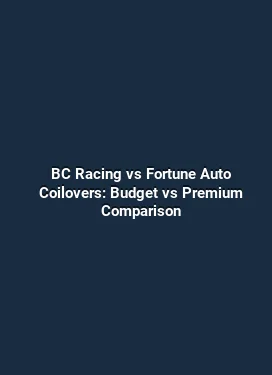Polyurethane vs Rubber Suspension Bushings: NVH and Performance
Understanding the Role of Suspension Bushings in Vehicle Dynamics

Suspension bushings are essential connectors between the vehicle frame and the suspension arms. They serve multiple purposes: isolating metal-to-metal contact, controlling wheel alignment under load, and transmitting steering inputs with a predictable feel. The choice of material for these bushings can influence ride quality, steering response, and overall handling. In practice, this choice becomes a trade-off between compliance and control. Rubber has long been the standard due to its natural damping properties and excellent isolation, while polyurethane offers a stiffer alternative that can sharpen response but may alter NVH characteristics. For enthusiasts and professionals alike, the decision hinges on the driving environment, maintenance habits, and target performance.
To appreciate the difference, it helps to consider the primary performance axes: damping and stiffness, fatigue resistance, and thermal behavior. Damping determines how quickly vibrations are attenuated after a road irregularity or a steering input. Stiffness affects how directly wheel movements translate into chassis motion, which in turn influences cornering feel and steering precision. Fatigue resistance concerns how bushings perform under the repeated loads typical of potholes, speed bumps, and aggressive cornering. Thermal behavior matters because bushings heat up under repeated loading, and material properties shift with temperature. Each material family—rubber and polyurethane—has a distinct profile across these axes that becomes evident in real-world testing and track-focused setups.
Material Fundamentals: Rubber vs Polyurethane
Rubber bushings are typically natural or synthetic elastomers with a compliant matrix that absorbs road noise and minor vibrations. Their core strength lies in excellent intrinsic damping, which helps isolate the cabin from road disturbances. The elastomeric matrix deforms under load, converting some kinetic energy into heat and reducing peak forces transmitted into the chassis. The downside is that the same damping that protects occupants can also blunt feedback and reduce steering immediacy in performance-oriented applications.
Polyurethane bushings, by contrast, use a hard, densely packed polymer with crosslinks that resist deformation more than rubber. This yields higher stiffness and improved resistance to radial and shear loads. The result is more precise steering response and less wheel motion under load, which is desirable for aggressive handling and consistent tire contact during cornering. However, the inherent stiffness can transmit more road feel into the cabin and may amplify certain types of NVH, especially on rough surfaces. Modern formulations have addressed some of these concerns with advanced blends and lubricants, but the fundamental material behavior remains a key differentiator.
NVH Considerations: Noise, Vibration, Harshness
NVH performance is a central consideration when choosing bushings. Rubber typically excels at isolating noise and smoothing out vibration. The damping qualities of rubber help absorb tire hum, engine vibrations, and road textures, resulting in a quieter, more comfortable ride on everyday roads. For daily driving, this is a major advantage. In terms of vibration, rubber tends to limit higher-frequency transmission, which reduces perceived harshness in the cabin.
Polyurethane tends to transmit more vibration at lower frequencies and potentially more high-frequency noise into the cabin, particularly on coarse pavement. However, modern polyurethane formulations incorporate engineered internal geometry, lubricants, and durometers designed to balance damping with stiffness. The result can be improved vehicle feel and feedback without an unacceptable rise in cabin noise on well-maintained roads. For performance-oriented builds, drivers may accept a modest increase in NVH in exchange for sharper steering and more predictable tire contact. The NVH equation also depends on the bushing geometry, attachment points, and how the bushing is toleranced within the suspension linkage.
Temperature and Aging Effects

Temperature has a pronounced effect on both rubber and polyurethane. Rubber tends to soften at high temperatures, which can reduce stiffness and alter alignment characteristics. Aging can lead to cracking and loss of damping consistency, especially in environments with UV exposure or ozone. Polyurethane generally handles heat better and maintains stiffness over a broader temperature range, which helps preserve handling and consistency in high-load conditions. Over time, polyurethane can become less compliant as crosslinking and filler systems resist deformation; this change is usually gradual and predictable with proper maintenance. Understanding these dynamics helps in selecting bushings that align with climate, road conditions, and driving frequency.
Wear, Durability, and Fatigue Life
Durability is a critical factor for bushings because they operate under repetitive loading and cyclical deformation. Rubber's resilience and damping come at the cost of faster fatigue under high-load, high-frequency scenarios. Rubber can degrade from exposure to oils, solvents, and environmental conditions, leading to hardening, cracks, and compromised isolation over time. When bushings fail, symptoms include clunking noises, increased body roll, or misalignment under load. Replacing worn rubber bushings with a properly selected solution helps restore original geometry and ride quality.
Polyurethane offers high abrasion resistance and superior fatigue life in many loading conditions. Its resistance to tearing and extrusion under pressure makes it a favorable choice for aggressive alignment changes and track usage. However, under extreme continuous loads or poor lubrication, polyurethane can suffer from increased friction or sticking, which may alter movement and ride quality. Bearings or sleeves within polyurethane assemblies may wear; selecting the correct durometer and lubricant compatibility is essential for optimum longevity. Practitioners often compare the total cost of ownership, factoring in replacement intervals, road conditions, and maintenance practices to determine the best fit.
Lubrication, Fitment, and Assembly Tolerances
Effective socking of bushings relies on precise fitment and appropriate lubrication strategies. Rubber bushings often benefit from natural lubrication characteristics of the material and compatible greases; over-lubrication can reduce friction benefits and wash out damping properties. Polyurethane assemblies may require specific lubricants to minimize sticking and ensure consistent movement through temperature swings. In both cases, correct installation torque, alignment, and bushing pre-load are crucial. Improper fitment can lead to accelerated wear, noise, or degraded handling. When upgrading to polyurethane, engineers pay close attention to the bushing housing geometry and adjust the pre-load to preserve correct suspension geometry while preserving steering feel.
Real-World Scenarios: Handling, Comfort, and Track Readiness
On smooth highways, rubber bushings often deliver the most comfortable and quiet ride with ample isolation from tire noise. The damping characteristics minimize cabin intrusion, and the suspension remains compliant to small imperfections, contributing to a smooth driving experience. In performance-oriented street setups, polyurethane bushings can provide a more direct steering response and improved tire contact during aggressive cornering. The steering feel becomes more immediate, and chassis control can improve due to reduced compliance in the linkages. The caveat is a potential uptick in NVH that some drivers may perceive as increased road feedback or harshness on rough segments.
Track environments reveal different dynamics. Rubber’s damping can be advantageous for comfort but may allow more wheel movement under high-G loading, lowering tire grip in some high-performance corners. Polyurethane’s stiffness translates to more consistent geometry under load, helping maintain tire contact and predictability through the exit of turns. Drivers often report improved turn-in response and reduced understeer tendencies with polyurethane in well-engineered kits, though this is highly dependent on overall suspension tuning, tire selection, and chassis rigidity. In any case, the optimal choice depends on the vehicle’s purpose, the road surface quality, and the driver’s preference for feedback versus isolation.
Suspension Tuning and Upgrade Considerations
When upgrading bushings, several practical steps help ensure a successful outcome. First, assess the vehicle’s baseline: ride quality, steering accuracy, and NVH levels. Next, choose a durometer and formulation that matches the desired balance of stiffness and isolation for the application. For street-focused builds, a mid-range polyurethane with controlled damping characteristics can offer improved control without excessive NVH. For track-oriented or aggressive driving scenarios, higher stiffness formulations paired with robust mounting hardware can maximize handling while maintaining acceptable reliability. Finally, ensure compatibility with other suspension components, such as sway bars and control arms, to preserve the intended suspension geometry. A well-planned upgrade often includes monitoring wear indicators and performing periodic inspections to catch misalignment or unusual wear early.
Maintenance and Diagnostic Insights
Maintenance plays a pivotal role in preserving performance and NVH characteristics. Rubber bushings typically require attention for signs of cracking, deformation, or oil contamination, which can degrade damping properties and allow unwanted movement. Diagnosing issues involves listening for clunks, watching for changes in steering response, and inspecting bushing wear under close observation. Regular lubrication of moving parts and ensuring clean, dry mounting surfaces help in extending life and maintaining consistent behavior.
With polyurethane, inspections focus on signs of extrusion, cracking at edges, or unusual stiffness changes. Because polyurethane is less forgiving of misalignment, careful mounting is critical. In high-load environments, periodic checks for uniform wear across the bushing and alignment verification are advised. Maintenance schedules should reflect the vehicle's usage patterns, climate, and road quality to keep performance consistent over time.
Choosing the Right Bushing Strategy for Your Vehicle
Choosing between rubber and polyurethane requires a clear understanding of the vehicle’s intended use. For daily drivers prioritizing comfort and quiet operation, rubber remains a compelling option. For enthusiasts seeking sharper handling and consistent performance under load, polyurethane offers compelling benefits when properly selected and installed. Ultimately, the best approach is to evaluate driving goals, test on representative roads or a controlled environment, and consider long-term maintenance implications. Real-world testing with a few driving scenarios—circuit-like laps, winding roads, and highway cruising—can reveal how each material behaves under the specific conditions the vehicle will face. This pragmatic approach tends to deliver the most meaningful performance gains without sacrificing reliability or comfort.
Conclusion: Weighing Trade-offs in Suspension Design
Both rubber and polyurethane suspension bushings bring distinct strengths to vehicle dynamics. Rubber offers excellent NVH damping and a forgiving ride, making it a natural fit for comfort-focused applications and everyday driving. Polyurethane provides a more direct, responsive feel and improved fatigue resistance, which can translate to enhanced handling and predictable performance in demanding scenarios when correctly implemented. The decision rests on a holistic view of the vehicle’s use case, road conditions, maintenance practices, and the driver’s priority between ride comfort and steering precision. By examining material properties, thermal behavior, wear patterns, and real-world driving feedback, builders and drivers can tailor suspension behavior to achieve the desired balance of comfort and control while preserving reliability over time.






